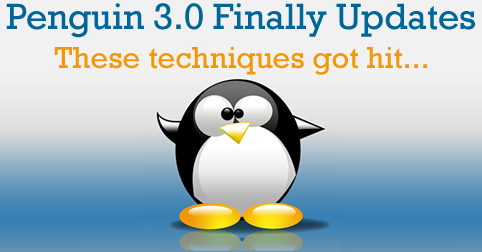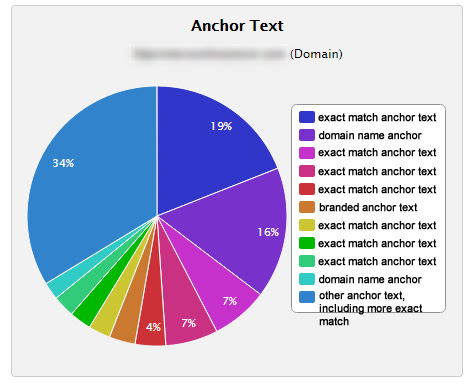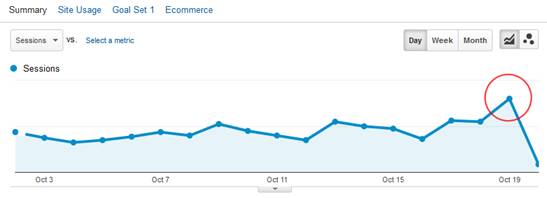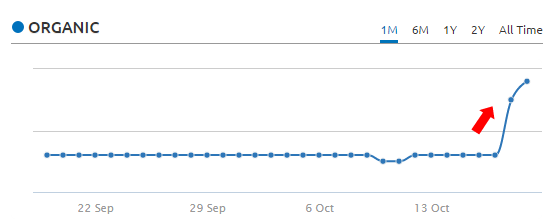 After waiting more than a year, the Penguin 3.0 update has finally rolled out.
After waiting more than a year, the Penguin 3.0 update has finally rolled out.
Google has emailed me to confirm that Penguin did roll out on Friday, at the same time forums and Twitter began to light up about a possible Penguin update rolling out, but said they might not release any further details or information on % impact for this one.
The rollout began on Friday, October 17, 2014, more than a year after the previous Penguin algo update. Google seemed to roll this particular update out to international sites first, before beginning the US rollout.
While the update targets spammy link techniques, some experts are definitely seeing some clearly spam link driven sites ranking very well. “If this was the real Penguin update, the link buyers must be over the Moon,” was Dave Naylor‘s first reaction. In one example he sent me for a highly competitive keyword, spam link driven sites were 4 of the top 10 spots, including #2.
Naylor, of Bronco, sees many sites that he thought would get wiped out with the latest Penguin not get touched and rank top 10 for very competitive (and highly spammed) keywords. “Let’s hope that this update has NOT finished and it still running out.. because if it’s not over I can’t see how NON link manipulating sites can survive.”
But for sites that did get penalized, there seems to be some anchor text indicators that Google was looking at. And it is obvious some webmasters weren’t taking cues from previous Penguin updates with regards to anchor text and anchor text variety.
Glenn Gabe, of G-Squared Interactive, sees typical Penguin-like link profiles taking a hit with “very spammy followed links, heavy exact match anchor text, and all from low-quality sites. For example, I saw many article directories, spammy ‘business’ directories, link exchange programs, comment spam, forum spam, etc. One site in particular blew me away. It looks like most of their links were set up right after Penguin 2.1! I saw links that were created only two days after Penguin 2.1 rolled out! Either they didn’t know much about Penguin, or they were ready to take a huge risk…”
Gabe also posted on Google+ the anchor text profile for a site that got hit, calling it a “very Penguin-like link profile” with exact match anchor text.
 For those sites that did see Penguin recovery, after being hit over a year ago with the last Penguin update, saw definite increases in traffic.
For those sites that did see Penguin recovery, after being hit over a year ago with the last Penguin update, saw definite increases in traffic.
Gabe shared this screenshot from SEMRush for a client that had worked hard on cleaning up a bad link profile, which shows a huge spike on Saturday and a continued upward trend on Sunday, which also highlights the fluctuations of the rollout.
And here is another screenshot he shared showing the pop on Sunday (the following day drop is simply from an incomplete day of reporting).
 So what was impacted? Here is what we know…
So what was impacted? Here is what we know…
Internal pages ranking after homepage removed
There are some reports that homepages for sites have been deindexed, but internal pages are replacing the homepage in the search results. It is unknown if this is a partial penalty or if it is an issue with a longer roll out of Penguin and eventually those internal pages will be deindexed as well. But it is unusual as most sites hit with a Penguin penalty previously don’t rank for any pages. It is rare (although not unheard of) that Google simply penalizes a homepage while allowing the remaining site to continue ranking for competitive keywords.
International hit first
Penguin rolled out on international Google sites including Google.co.uk, Google.de and Google.fr first, instead of rolling out within the US first. Glenn Gabe noticed US starting to roll out on Sunday morning.
“I’ve been heavily analyzing Penguin since early Saturday morning, including many fresh hits,” says Gabe. “In my opinion, this looks like a slow and steady rollout with international sites first seeing impact (both positive and negative impact). I saw the first signs of US-based sites seeing impact Sunday morning, but many were still not being impacted (not like Australia, U.K., etc.)
301 redirect penalties
Some people have noticed that sites utilizing 301 redirects to get around previous penalties seem to have been impacted. This is definitely seen as a grey to black area for SEO, but it can have results.
Affiliate sites hit hard
While affiliate sites tend to be the ones most often designed as “churn and burn”, it seems that this update may have specifically tried targeting affiliate sites with the number of sites that are reporting being impacted by the latest Penguin.
Link profiles
Link profiles play key role, as Gabe noted. But link profiles have always been important with Penguin and those who stuck with typical link profiles for sites that matched link profiles for sites that were penalized in the last update got hit this time around too.
Automated ranking & spam link network programs hit
Tools such as GSA and additional private blog link networks (PBNs) seem to have been impacted, although we did see many of them previously penalized earlier this year. However, some webmasters say that careful usage of these tools resulted in no Penguin impact this time around. Especially with PBNs, a lot has to do with how they are implemented and exactly how private they are.
Penalty notices
Penalty notices do not seem to have gone out in Google Webmaster Tools accounts as of yet, alerting webmasters to the penalty.
Disavow snapshot for update is weeks old
Do keep in mind that the snapshot used for disavows was from the middle of September, so if you have disavowed any links within the last month, it likely would have had no impact on this Penguin update.
If you got hit…
When you get penalized by Penguin, you need to clean up the problems before the next update goes out. There was talk of Penguin moving towards a rapid refresh cycle where we would see it update much more frequently – similar to Panda – so that webmasters aren’t stuck waiting more than a year to come back from Penguin purgatory. However, this still remains to be seen whether this will happen or not.
Update: Penguin 3.0 affects less than 1% of queries and will roll out for weeks.

Gary McKinnon says
Good article, thanks.
BTW, it’s ‘cues’, not ‘queues’ in this context.
Yes, i’m a spelling Nazi ;+}
Jennifer Slegg says
That’s what I get for writing about the update at 3 in the morning Fixed!
Fixed!
Pears Jobson says
I have been hit, the homepage just disappeared and a sub page is coming up far lower in the rankings. I think it may be caused by some same keyword blog comment spam the SEO guys did almost 2 – 3 years ago. Unfortunately I have to sit down and get them removed one by one.
Daniel Valaperta says
Hi Jennifer,
Just wanted to let you know this is the best post we’ve read covering Penguin 3.0. Our staff picked it to be published in our Sept/Oct Online Marketing Article Roundup – posted on our company blog.
Thanks for the article!
Daniel
Apex Internet
Mike P says
This is fluffy reporting. If you want to really understand Penguin you need large datasets and statistical analysis. This is why building lots of sites and having perfect inventory of you link building is the best way to understand these algorithm updates.
Jennifer Slegg says
You also have to remember it was only out for a few days and there was still a lot of questions about whether it was an update or merely a refresh. That said, most SEOs don’t want to publicly share their personal datasets and statistical analysis of this kind of thing when they can use it to their advantage instead